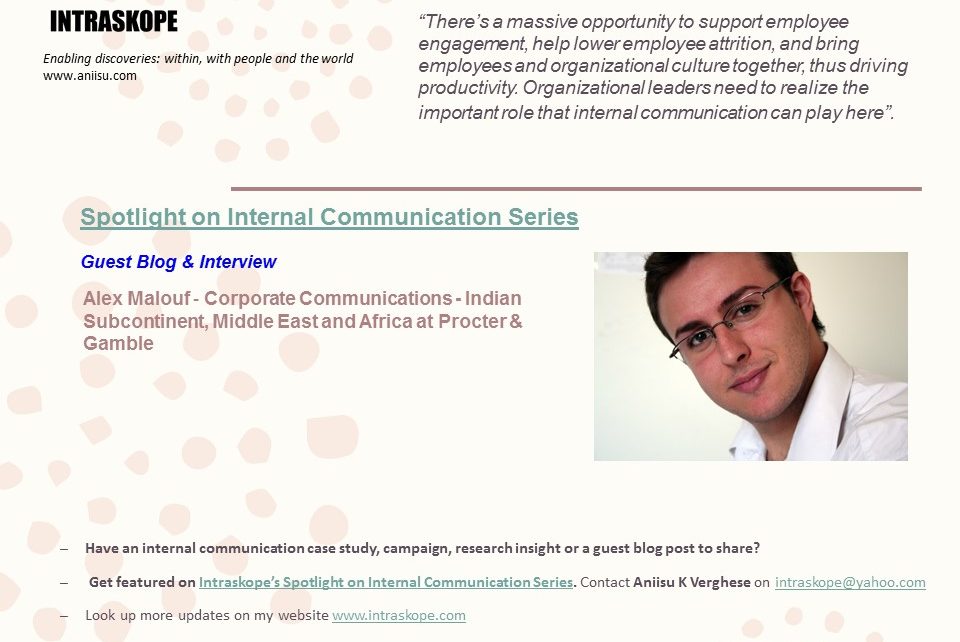How can we identify and involve influencers internally? What will nudge the organization to value internal communications more? When do leaders see the benefits of this important function?
Alex Malouf of Proctor & Gamble shares his perspectives in the 24th edition of Intraskope’s Spotlight on Internal Communication Series.
Former journalist Alex Malouf has carved out a niche as a lively voice in the Middle East’s burgeoning media scene, combining razor-sharp observations with a keen understanding of the forces that underpin the region’s digital transformation. Much of which, no doubt, is informed by Malouf’s day job at P&G, where he manages reputational affairs for the Middle East’s largest FMCG. Malouf’s experience and roots in the region are not the only things that set him apart — he is also a highly visible advocate for modern public relations, serving in senior roles on numerous industry organizations.
Read on and share your feedback.
Blog
Developing an internal communications function in emerging markets
Much has been published on internal communications in developed markets, but little has been written on the function in emerging markets. In the region where I work, the Middle East and Africa, communicators are predominantly generalists. There are fewer specialized internal communicators, and less awareness of internal communications theory. Instead, the common approach to internal messaging is to cascade information from the top. This description shouldn’t be seen negatively; communications in the emerging world is changing at a faster pace than in many mature markets. There are a number of methods that communicators can and should use to foster an organizational environment that promotes internal communications.
- Earn and Build Trust: It may sound obvious, but trust is essential to any relationship. This is especially so in a region such as the Middle East and Africa, where much of what is communicated and understood is informal (i.e. spoken and heard), rather than formal (i.e. written). By engaging with the leadership, listening to their concerns and understanding what matters to them, you’ll be able to build up trust, which will give you the latitude to undertake more creative/unconventional activities as time passes.
- Involve Organizational Influencers: The initial focus will be on pushing information from the top to the bottom of the organization. Look to engage others who are influential, be they those who are close to and trusted by management, as well as those who are the informal center of their teams. Slowly build up the number of communications and stories that involve these two groups of people, so that both management and the wider organization get used to hearing different voices.
- Build a News Room: Authentic stories matter, and the best way to engage with employees is through building a news room and crafting stories on subjects that involve and matter to them. By bringing to life stories about your employees, you humanize the company. You also drive employee loyalty and productivity. The news room concept requires establishing processes and contacts for hearing about stories throughout the organization, as well as creating editorial standards that results in stories that are written for the readers (employees), rather than for management. Once you’re at the third stage, you’ll see the difference in engagement through your measurement KPIs, be it the number of views, comments, time spent on the site, and even anecdotal evidence such as an increase in employees and managers reaching out to you to talk about the story, and asking how they can participate.
These are three steps to get your internal communication function up to speed, especially in a market and organization which isn’t used to having a dedicated approach to the concept.
There’s much more to discuss, and it’s by no means easy to guide management – and the communications team – to the third stage, especially when they have a traditional view on what internal communications is about and what it should achieve. Good luck and I wish you all the best!
Interview
- What does internal communication mean to you?
At its best, internal communication is all about promoting a strong organizational culture and dialogue within the organization, celebrating diversity and inclusion, helping everyone understand how they can best align and contribute, as well as creating a climate where we can talk openly about what is both good as well as what can be improved within the organization.
- What is the biggest challenge you face while going about managing internal communication?
The challenge we all face is getting internal communications to be a stand-alone function. We should work closely with others, but I don’t believe that internal communications should report to HR. Internal communications should not be seen as a means to cascade information from top to bottom (this is often the case where I am). And then there’s the usual resourcing issues.
- What according to you is the biggest opportunity that internal communicators have?
There’s a massive opportunity to support employee engagement, help lower employee attrition, and bring employees and organizational culture together, thus driving productivity. Organizational leaders need to realize the important role that internal communications can play here.
- What is your advice for people who are keen to join internal communication and make a career? What skills must they have or develop?
In emerging markets, there are relatively few internal communications roles. Look to get your foot into the door in a generalist role, and start influencing your role from within, by slowly taking up more projects/assignments which are internal communications-focused. Basically, create a role for yourself.
Missed previous stories from organizations featured on the Intraskope’s Spotlight on Internal Communication Series? Look them up here – Infosys, SOBHA Ltd., ICICI Securities, First Advantage, CK Birla Group, TVS Motors, GE, Suzlon, Tata Sons, Percept, Knight Frank, TCS Europe, Vedanta, Oxfam, Danske Bank, Diageo, Pandora, Symantec, ISS Global Services, Telia, Thomson Reuters, IBM and Philips.
If you are an internal communication leader working in a firm or a not-for-profit anywhere in the world and have an internal communication case study, campaign, research insight or a guest blog post to share please contact me on [email protected]
You can also visit my website www.intraskope.com and You Tube channel to know more about my work



